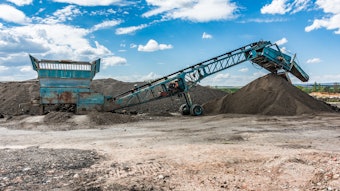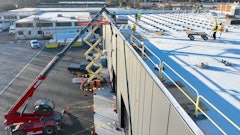
There are approximately 143 million tons of construction and demolition (C&D) waste in the United States, but according to Waste Business Journal, only 25% of that waste is recycled. In fact, 40% of all waste in landfills is C&D waste.
Today’s contractors have taken notice. With landfill and transportation costs rising and new recycling requirements popping up everywhere, waste disposal has become a major cost component of demolition and renovation bids.
According to the report Sustainable Construction Waste Management – Creating Value in the Built Environment, published jointly between McGraw-Hill Construction (www.construction.com) and Waste Management (www.wm.com), contractors place sustainable waste management and existing structure reuse as the second and third most important aspects of green building — just behind energy efficiency.
“I was surprised by this finding,” says Jim Halter, LEED AP+BD&C Vice President for Construction Solutions at Waste Management.
“I thought the order would have been closer to 1) water, 2) air quality, etc., with sustainable waste management lower on the list. However, a number of additional studies by other sources corroborates our findings that contractors view waste management as the second most important influence to green building practices, and that diverting of waste will go beyond regulatory compliance to providing diverse recycling services for complex materials diversion.”
Companies like Waste Management have also noticed. Through its 45,000 employees, the Houston-Texas-
headquartered provider of waste management services is committed to environmental performance — its
mission is to maximize resource value, while minimizing environmental impact so both the economy and the environment can thrive. As North America’s
largest recycler, Waste Management managed more than 10 million tons of recycled materials and is now more than halfway to its goal of managing 20 million tons each year. The company recycled enough material in 2010 to fill a football field 2.11 miles high.
Designing to prevent waste
An increasing number of construction companies and manufacturers alike are seeking innovative and integrated product designs to waste management and environmental solutions — from the design phase to construction and ultimately to occupancy and facility management — whether to achieve LEED certification or for their own sustainability goals.
The total waste generated by a project can be greatly reduced by considering waste generation during the design phase, employing conservative purchasing practices and by reusing excess materials at the jobsite.
“We see waste as a resource to be recovered,” says Halter. “We work with contractors and businesses from the beginning of a project to develop and execute strategies to reduce, reuse, recycle or otherwise minimize waste — consequently minimizing their operations’ impact on the environment, all while saving our customers money.”
The most common C&D materials can be recycled,
including:
- Wood — forming and framing lumber, stumps, plywood, laminates, scraps
- Drywall — sheetrock, gypsum, plaster
- Metals — pipes, rebar, flashing, steel, aluminum, copper, brass, stainless steel
- Plastics — vinyl siding, doors, windows, floor tiles, pipes
- Roofing— asphalt and wood shingles, slate, tile, roofing felt
- Rubble — asphalt, concrete, cinder blocks, rock, earth
- Brick — bricks, decorative blocks
- Glass — windows, mirrors, lights
- Miscellaneous — carpeting, fixtures, insulation, ceramic tile
“The goal is always to retain as much value from these materials as possible,” stresses Halter. “We owe that to our customers.”
Here are a few examples of how recycled C&D materials can be converted into new resources:
- Cardboard, paper, plastics and metals — converted into new goods
- Clean wood — mulch or biomass fuel
- Dirt, rock and sand — Alternative Daily Cover (ADC) in landfills
- Crushed concrete — gravel or dry aggregate for new concrete
- Inerts — road base
By minimizing construction inputs, buying recycled products and using salvaged building materials, building projects can achieve substantial cost savings. Eliminating waste at the source, known as source reduction, saves money and valuable landfill space. There are many opportunities to implement source reduction strategies on construction sites.
A proactive approach
According to the EPA, materials can be reduced during the design phase by planning for efficient framing techniques, using standardized lumber sizes and incorporating prefabricated or modular materials. Value engineering focuses on maximizing resources while maintaining construction value, which results in a finished project that performs the required functions while utilizing the least amount of resources.
Halter agrees. “The earlier you address waste management and the more collaborative the approach, the better.”
Tracking is also very important, especially when there are a number of trades involved (Waste Management offers a web-based Online Recycling and Diversion Tracking tool. Learn more at www.wm.com/DART.)
The EPA offers additional techniques to help reduce costs and prevent waste:
- Increase the spacing of joists and studs, or use 2-by-4 studs instead of 2-by-6 studs; extra insulation can be used in other areas to make up for decreased wall thickness.
- Use a computer assisted design (CAD) program to optimize plywood and drywall use.
- Advanced framing is a system that combines increased spacing of floor joists, reduced headers, and expanded placement of studs (24 in. on center instead of 16 in.). This system requires less material and uses sized lumber more efficiently.
- Use standard lumber sizes in building design to minimize cutoff waste. The use of modular and prefabricated wall sections and trusses can also reduce onsite waste by eliminating cuttings.
- Use steel framing members as an alternative to wood. In addition to being recyclable, steel is stronger and lighter, reduces construction time and costs and provides greater seismic tolerance.
- Many modern buildings make a statement by exposing structural elements. Take advantage of a “less is more” design approach as an opportunity to reduce waste. Additional benefits include decreased costs and opportunities for improved daylighting and indoor air quality.


![Img 1707[56]](https://img.forconstructionpros.com/files/base/acbm/fcp/image/2023/04/IMG_1707_56_.6437076c97961.png?auto=format%2Ccompress&fit=crop&h=191&q=70&rect=0%2C462%2C1920%2C1080&w=340)
















![Glp Porsche 072723 465 64ee42287c29e[1]](https://img.forconstructionpros.com/files/base/acbm/fcp/image/2024/03/GLP_PORSCHE_072723_465.64ee42287c29e_1_.65e88b8589b9c.png?auto=format%2Ccompress&fit=crop&h=135&q=70&rect=0%2C520%2C2250%2C1266&w=240)







